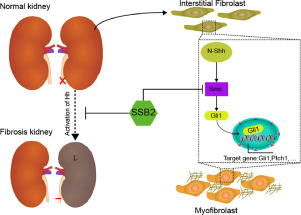当前位置:
X-MOL 学术
›
Phytomedicine
›
论文详情
Our official English website, www.x-mol.net, welcomes your
feedback! (Note: you will need to create a separate account there.)
Saikosaponin B2 attenuates kidney fibrosis via inhibiting the Hedgehog Pathway.
Phytomedicine ( IF 6.7 ) Pub Date : 2019-12-28 , DOI: 10.1016/j.phymed.2019.153163 Dadui Ren 1 , Jia Luo 1 , Yingxue Li 1 , Jing Zhang 1 , Jiahong Yang 1 , Junqiu Liu 2 , Xuemei Zhang 1 , Nengneng Cheng 1 , Hong Xin 1
Phytomedicine ( IF 6.7 ) Pub Date : 2019-12-28 , DOI: 10.1016/j.phymed.2019.153163 Dadui Ren 1 , Jia Luo 1 , Yingxue Li 1 , Jing Zhang 1 , Jiahong Yang 1 , Junqiu Liu 2 , Xuemei Zhang 1 , Nengneng Cheng 1 , Hong Xin 1
Affiliation

|
BACKGROUND
Renal interstitial fibrosis is a common pathway through which chronic kidney disease progresses to end-stage renal disease. There are currently no effective drugs available to treat kidney fibrosis, so traditional medicine is likely to be a candidate. The therapeutic potential of saikosaponin B2 (SSB2), a biologically active ingredient of Radix Bupleuri, on renal fibrosis has not been reported.
METHODS
A unilateral ureteral obstruction (UUO) model was conducted to induce renal interstitial fibrosis in mice. SSB2's effect was valuated by histological staining and exploring the changes in expression of relative proteins and mRNAs. A conditional medium containing sonic hedgehog variant protein stimulating normal rat kidney interstitial fibroblast cells (NRK-49F) was used in an in vitro model to determine the possible mechanism. The molecular target of SSB2 was verified using several mutation plasmids.
RESULTS
SSB2 administration reduced kidney injury and alleviated interstitial fibrosis by decreasing excessive accumulation of extracellular matrix components in UUO mice. It could also reduce the expression of α-SMA, fibronectin and Gli1, a crucial molecule of the hedgehog (Hh) signaling pathway both in vivo and in vitro. In NIH-3T3 cells simulated by conditional medium containing sonic hedgehog variant protein, SSB2 showed the ability to decrease the expression of Gli1 and Ptch1 mRNA. Using a dual-luciferase reporter assay, SSB2 suppressed the Gli-luciferase reporter activity in NIH-3T3 cells, and the IC50 was 0.49 μM, but had no effect on the TNF-α/NF-κB and Wnt/β-catenin signaling pathways, indicating the inhibition selectivity on the Hh signaling pathway. Furthermore, SSB2 failed to inhibit the Hh pathway activity evoked by ectopic expression of Gli2ΔN and Smo D473H, suggesting that SSB2 might potentially act on smoothened receptors.
CONCLUSION
SSB2 could attenuate renal fibrosis and decrease fibroblast activation by inhibiting the Hh signaling pathway.
中文翻译:

Saikosaponin B2通过抑制刺猬通路来减轻肾脏纤维化。
背景技术肾间质纤维化是慢性肾脏疾病发展为终末期肾脏疾病的常见途径。当前没有有效的药物可用于治疗肾纤维化,因此传统药物可能会成为候选药物。柴胡皂甙的生物活性成分-皂苷B2(SSB2)对肾纤维化的治疗潜力尚未见报道。方法采用单侧输尿管梗阻(UUO)模型诱导小鼠肾间质纤维化。通过组织学染色和探索相关蛋白和mRNA表达的变化来评估SSB2的作用。在体外模型中,使用含有刺激正常大鼠肾间质成纤维细胞(NRK-49F)的刺猬蛋白变体蛋白的条件培养基,以确定可能的机制。使用几种突变质粒验证了SSB2的分子靶标。结果SSB2给药通过减少UUO小鼠中细胞外基质成分的过度积累,减少了肾脏损伤并减轻了间质纤维化。它还可以降低α-SMA,纤连蛋白和Gli1的表达,Gli1是体内和体外刺猬(Hh)信号传导途径的关键分子。在含有声波刺猬蛋白变异蛋白的条件培养基模拟的NIH-3T3细胞中,SSB2具有降低Gli1和Ptch1 mRNA表达的能力。使用双荧光素酶报告基因测定法,SSB2抑制了NIH-3T3细胞中的Gli荧光素酶报告基因活性,IC50为0.49μM,但对TNF-α/NF-κB和Wnt /β-catenin信号通路没有影响,表明对Hh信号通路的抑制选择性。此外,SSB2无法抑制由Gli2ΔN和Smo D473H异位表达引起的Hh通路活性,这表明SSB2可能可能作用于平滑受体。结论SSB2可以通过抑制Hh信号通路来减轻肾纤维化并降低成纤维细胞的活化。
更新日期:2019-12-29
中文翻译:

Saikosaponin B2通过抑制刺猬通路来减轻肾脏纤维化。
背景技术肾间质纤维化是慢性肾脏疾病发展为终末期肾脏疾病的常见途径。当前没有有效的药物可用于治疗肾纤维化,因此传统药物可能会成为候选药物。柴胡皂甙的生物活性成分-皂苷B2(SSB2)对肾纤维化的治疗潜力尚未见报道。方法采用单侧输尿管梗阻(UUO)模型诱导小鼠肾间质纤维化。通过组织学染色和探索相关蛋白和mRNA表达的变化来评估SSB2的作用。在体外模型中,使用含有刺激正常大鼠肾间质成纤维细胞(NRK-49F)的刺猬蛋白变体蛋白的条件培养基,以确定可能的机制。使用几种突变质粒验证了SSB2的分子靶标。结果SSB2给药通过减少UUO小鼠中细胞外基质成分的过度积累,减少了肾脏损伤并减轻了间质纤维化。它还可以降低α-SMA,纤连蛋白和Gli1的表达,Gli1是体内和体外刺猬(Hh)信号传导途径的关键分子。在含有声波刺猬蛋白变异蛋白的条件培养基模拟的NIH-3T3细胞中,SSB2具有降低Gli1和Ptch1 mRNA表达的能力。使用双荧光素酶报告基因测定法,SSB2抑制了NIH-3T3细胞中的Gli荧光素酶报告基因活性,IC50为0.49μM,但对TNF-α/NF-κB和Wnt /β-catenin信号通路没有影响,表明对Hh信号通路的抑制选择性。此外,SSB2无法抑制由Gli2ΔN和Smo D473H异位表达引起的Hh通路活性,这表明SSB2可能可能作用于平滑受体。结论SSB2可以通过抑制Hh信号通路来减轻肾纤维化并降低成纤维细胞的活化。











































 京公网安备 11010802027423号
京公网安备 11010802027423号